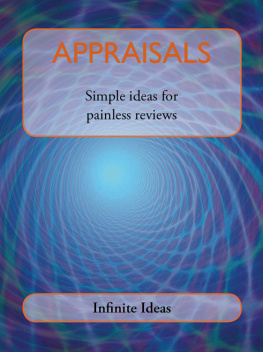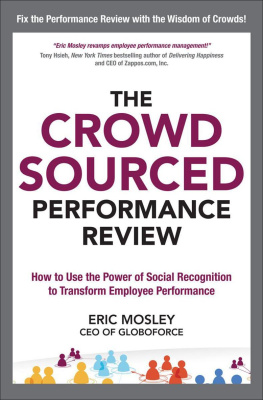Win-Win Performance Appraisals
Win-Win Performance Appraisals
Get the Best Results for Yourself and Your Employees: What to Do Before, During, and After the Review
Lawrence Holpp


Copyright 2012 by The McGraw-Hill Companies, Inc. All rights reserved. Printed in the United States of America. Except as permitted under the United States Copyright Act of 1976, no part of this publication may be reproduced or distributed in any form or by any means, or stored in a database or retrieval system, without the prior written permission of the publisher.
ISBN: 978-0-07-173985-6
MHID: 0-07-173985-8
The material in this eBook also appears in the print version of this title: ISBN: 978-0-07-173611-4, MHID: 0-07-173611-5.
All trademarks are trademarks of their respective owners. Rather than put a trademark symbol after every occurrence of a trademarked name, we use names in an editorial fashion only, and to the benefit of the trademark owner, with no intention of infringement of the trademark. Where such designations appear in this book, they have been printed with initial caps.
McGraw-Hill eBooks are available at special quantity discounts to use as premiums and sales promotions, or for use in corporate training programs. To contact a representative please e-mail us at bulksales@mcgraw-hill.com.
TERMS OF USE
This is a copyrighted work and The McGraw-Hill Companies, Inc. (McGraw-Hill) and its licensors reserve all rights in and to the work. Use of this work is subject to these terms. Except as permitted under the Copyright Act of 1976 and the right to store and retrieve one copy of the work, you may not decompile, disassemble, reverse engineer, reproduce, modify, create derivative works based upon, transmit, distribute, disseminate, sell, publish or sublicense the work or any part of it without McGraw-Hills prior consent. You may use the work for your own noncommercial and personal use; any other use of the work is strictly prohibited. Your right to use the work may be terminated if you fail to comply with these terms.
THE WORK IS PROVIDED AS IS. McGRAW-HILL AND ITS LICENSORS MAKE NO GUARANTEES OR WARRANTIES AS TO THE ACCURACY, ADEQUACY OR COMPLETENESS OF OR RESULTS TO BE OBTAINED FROM USING THE WORK, INCLUDING ANY INFORMATION THAT CAN BE ACCESSED THROUGH THE WORK VIA HYPERLINK OR OTHERWISE, AND EXPRESSLY DISCLAIM ANY WARRANTY, EXPRESS OR IMPLIED, INCLUDING BUT NOT LIMITED TO IMPLIED WARRANTIES OF MERCHANTABILITY OR FITNESS FOR A PARTICULAR PURPOSE. McGraw-Hill and its licensors do not warrant or guarantee that the functions contained in the work will meet your requirements or that its operation will be uninterrupted or error free. Neither McGraw-Hill nor its licensors shall be liable to you or anyone else for any inaccuracy, error or omission, regardless of cause, in the work or for any damages resulting therefrom. McGraw-Hill has no responsibility for the content of any information accessed through the work. Under no circumstances shall McGraw-Hill and/or its licensors be liable for any indirect, incidental, special, punitive, consequential or similar damages that result from the use of or inability to use the work, even if any of them has been advised of the possibility of such damages. This limitation of liability shall apply to any claim or cause whatsoever whether such claim or cause arises in contract, tort or otherwise.
Contents
Acknowledgments
I would like to thank John Woods of CWL Publishing Enterprises for recruiting me to work on this book. And I owe a big debt of gratitude to Robert Magnan who did a great job of editing and helping me create the final manuscript. He had a lot to do with the creation of the book you now hold. Thanks Bob.
Introduction
With few exceptions, both managers and employees dread appraisal time. Managers are afraid of demotivating employees by giving them critical feedback and employees are afraid of receiving negative feedback that may threaten their jobs and even their careers. Both managers and employees may consider the process a waste of time and energy.
Performance appraisals are also expensive. Consider all the hours that a manager spends in planning, executing, and following up on performance appraisals. Consider the impact on each employee: the time spent thinking and talking about an upcoming appraisal, the time spent with his or her manager, the time spent thinking about the appraisal session and talking about it with other employees, and the loss in productivity and morale when the results are not good.
Performance appraisals can work. They can help organizations maintain focus on their strategic plan. They can enable managers to assess the performance of their employees. They can help employees know how well they are doing their jobs. They can provide a more solid basis for decisions on pay raises, promotions, and terminations.
What Is Your Situation?
If youre reading this book, chances are youre a manager who is required by your company to do performance appraisals on your employees. You may have had some training in doing them, but you are still a little uncertain about your ability to do them successfully without alienating your employees or getting into hot water. You may not have much experience in conducting appraisals, although you may have been subjected to many of them. Maybe you are new to managerial responsibilities. Or maybe youve just recently found out that youre expected to do performance appraisals. Maybe you have done lots of performance appraisals. A key quality of any manager should be an interest in managing more effectively and more efficiently. Its even possible that youre not required to do performance appraisals, but you think its a good idea. Thats smart, for the benefits for performance management and for the protection against legal liabilities.
Whatever your situation, helping you manage performance appraisals better is the purpose of this book.
The Purpose of Performance Appraisal
Performance appraisal is not about filling out a form. Its not even about having a performance appraisal meeting. Its about managing performance. Performance management is the larger heading under which performance appraisal falls, along with coaching, career development, compensation, feedback, objective setting, performance planning, mentoring, and employee engagement.
 Working Definition: Performance Management
Working Definition: Performance Management
The process by which management drives overall strategic objectives and goals into day-to-day goals and actions that translate into measurable results that improve business success.
Performance appraisal is one tool among many that can help a manager lead his or her employees to achieve results consistent with the goals of the organization and their business unit. If its the only tool employed, it will feel like a blunt instrument. If its used in concert with the other tools in the box, performance appraisal can become a highly effective means to do the following:
Improve manager-employee communication
Promote better work performance
Next page





 Working Definition: Performance Management
Working Definition: Performance Management